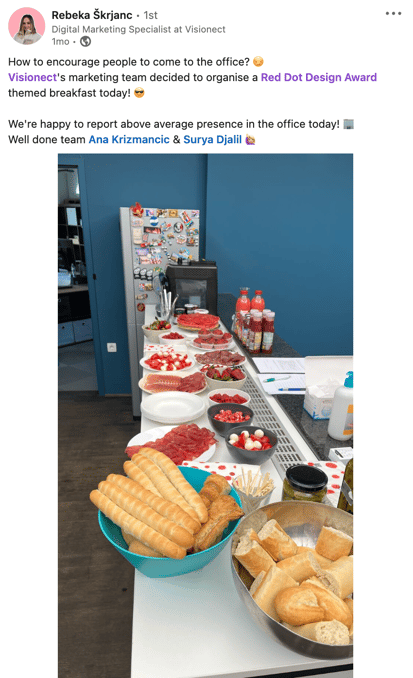For the past two years, companies have struggled to keep workplace culture in mind, and understandably so. The pandemic had every company at the end of their ropes, trying to simply figure out how to stay afloat and make sure their teams could succeed remotely. After months of unsteadiness, organizations had the wherewithal to pick up any lingering puzzle pieces that had been neglected in the struggle, such as employee experience and company culture. In doing so, companies were met with another quandary. Before 2020, most culture-building activities, events, or incentives were hosted on-site, in the office.
The problem was, hardly anyone was working in the office. Most of the world doesn’t realize just how much juggling and stress company executives dealt with during the transition to remote work. Yes, organizations successfully equipped their staff members with at-home computers, laptops, and other resources. Great! Employees could stay on top of their workload. But, how did these companies foster loyalty? Enthusiasm? Trust? Many didn’t. These companies are feeling the biggest impact of the Great Resignation. Employees are quitting, leaving one company for another. Why? In today’s day and age, poor company culture is the number one reason why employees quit their jobs.
Let’s dive deeper into the issue.
What is workplace culture?
“Workplace culture” is a phrase thrown about. We all know it’s important, but what is workplace culture? Is it the company values? The company’s goals? Beliefs? Outlook? Yes, to all of these and more. But, then we have to dig deeper, going from one vague notion to the next. What values? The values of the products and services? Or the internal values between employees including respect, empathy, and team support? Again, yes. What about company goals? The year-end goals? Quarterly success goals? Or goals to create an inclusive work environment where no one feels cut out. Yes.
Do you see where we’re going with this? Workplace culture can be everything profit-oriented and it can be everything that shapes the workplace experience for staff and executives. The key is, it’s hard to get everyone in a company on board with pursuing a company’s profit and success goals without first generating a sense of loyalty among employees. This loyalty comes from creating an inclusive, respectful culture within the organization. Companies can have the best strategy in the world, but it’s only as powerful, as driven, as the people behind it.
So, what is workplace culture? It’s everything from pursuing external success in the industry to achieving internal success as a whole, united unit from employees to executives.
Why is it important?
Workplace culture can be the driving force that makes your company successful in the long run. Sure, a startup can have short-term success with overworked employees and a great idea. But, without a sense of loyalty, employees will come and go, crippling the company with each loss.
In the words of Simon Sinek, author of Start with Why, “customers will never love a company until the employees love it first.” Employees are the heart and soul of any successful company. They’re the developers who care enough to learn what customers want in their products; the sales reps who rave about the company services; the support personnel who make the client feel valued.
By fostering company culture, companies create a strong, successful image that customers enjoy and naturally want to support.

What makes workplace culture?
In the words of Brittany Forsyth, VP of Human Relations at Shopify,
“Determine what behaviors and beliefs you value as a company, and have everyone live true to them. These behaviors and beliefs should be so essential to your core, that you don’t even think of it as culture.”
Unfortunately, the solution isn’t that easy, particularly this part: “have everyone live true to them.” I don’t know about Shopify, but most companies don’t have the power to brainwash people into adopting values on a whim.
So, how can companies nurture the same beliefs and values throughout the company? Brian Chesky of Airbnb had it right when he said, “culture is simply a shared way of doing something with a passion.” It’s the passion that drives employees to be loyal to a company and the company’s values. Passion is what makes teams strong, supporting the company as a whole. Peeling back the onion layers, here are some factors that affect workplace culture:
Employee wellbeing
Workplace culture is heavily influenced by employee wellbeing. Contributing factors include better work-life balance, support for long or short-term illnesses, job security, or even relationships grown within the company. Employees who feel well on the job and believe the company will support their journey to wellness are more content long-term.
Communication
There are dozens of avenues for communication within a company. Ultimately, the more transparent and inclusive a company is, the more at ease, confident, and trusting employees are. Not only do companies need to pave the way for inter-team communication, but the higher-ups also need to communicate what’s happening in the organization. Sharing information about the company’s successes, goals, and next steps, plus responding to employee concerns and feedback, can really make an organization resilient.
Engagement
Over the past two years, “engagement” has become a tricky ingredient. Most companies have been operating remotely since early 2020. Even now, the majority of organizations are transitioning to hybrid work conditions. Engaging employees throughout the company is no longer as simple as hosting an in-office potluck, sports day, or family event. Companies are muddling through, via trial and error, learning what works for their teams and what doesn’t. Still, their efforts aren’t in vain. Employees who are engaged feel like they’re a part of a community, connecting them to the company and their teammates alike.
For ideas on how to enhance employee engagement in this modern era of remote and hybrid work, check out our article, “How the pandemic can improve workplace culture.”
How can we improve it?
We’ve looked at the problem, why it’s significant, and the pieces that form workplace culture. Now, how about some solutions? Just as there’s no simple definition for workplace culture and no definitive genre of company values and goals, there’s no one cure-all solution. Instead, as workplace culture is created by fostering dozens of avenues, it takes multiple solutions to smooth the road.
Rely on employee feedback
No one can tell you how to improve the employee experience better than the employees themselves. The bigwigs can hum and haw over fresh ideas, try them out, and watch them succeed or fail. Or, they can respond to employee feedback and find a viable, if not great, solution pretty near every time.
What’s more, giving employees a chance to speak up helps them feel wanted, listened to, and cared for. In turn, they reciprocate the emotion, caring for the company that’s taking care of them.
Recognize achievements
Nothing detaches an employee more than a feeling of disconnect. If an employee feels that their efforts aren’t noticed or are underappreciated, they’ll lose momentum. Fast. Keep all of your employees motivated by recognizing achievements regularly. This process might include highlights on your company’s social channel, company-wide emails, team newsletters, or special mentions in company calls. Not to mention, company achievements are everyone’s business. A great way to keep employees engaged is to share the fruits of their labor. Check out how Visionect celebrated their Red Dot Award, credited to their state-of-the-art Joan 6 meeting room booking system.
Positive employee experiences
Workplace culture is stoked by company experiences. Yet, company experiences are stoked by workplace culture. Together, they create an ever-growing cycle — a mutual relationship that helps both elements mature and strengthen. When it comes to employee experiences, remember that it’s not just the good experiences that affect company culture. To generate a positive culture, companies need to make sure the positive experiences well outweigh the negative.
Here are two more considerations to improve your company culture:
Events and outings
While events are all the more difficult to arrange with the majority of employees out of the office on any given day, they’re not impossible. Consider inviting everyone into the office for special events. Or, if you’ve cut back on office space, rent an events site for company celebrations. For their Red Dot Award celebration, Visionect reported higher-than-average office attendance. Meaning, their celebration was a success! The lure of tasty treats convinced many of their teammates to come in for the event.

Technology
One key, surefire way you can improve company culture is to invest in the right tech that facilitates the work environment. You don’t have to buy expensive technology to make employees happy — just the right technology. Consider Slack: it’s a great messaging and conferencing tool that brings employees together, no matter their department or even timezone.
Next, with so many companies turning toward hybrid conditions, a booking solution can go a long way. Booking solution for what, you might ask? For everything. Desks, meeting rooms, office equipment, and even parking stalls can be made bookable with Joan. The booking system virtually eliminates bottlenecks and saves hours of wasted time.
With hybrid teams only working on-site two days a week, on average, employees need to make the most out of their time in the office. The right technology can significantly improve the office experience, helping employees focus on their jobs and teambuilding. Office hacks, like Joan, are some of the most affordable solutions with the biggest impact. For example, Joan 6 Pro is not only considered one of the most affordable options on the market, but it’s also the most cost-effective in the long run. Each device can last up to six months on a single charge — on the amount of energy it takes to brew one cup of coffee!
Start with feedback
All-in-all, keep employees in the loop where they have opportunities to share feedback about their work experiences. If they’re having communication troubles, investigate new conferencing platforms. If they’re having negative experiences with on-site reservations, consider a booking solution. The possibilities are endless and we’ve entered a new era of trial and error where the next prime solution is just around the corner.
Get in touch with our team for more tips, and ideas, or to learn how Joan can support your workplace culture.
Insights that keep your office running smoothly
Fresh content on productivity, space management, and the future of work. Perfect for managers, admins, and busy teams.
Join thousands of workplace professionals who already read the Joan blog. Unsubscribe anytime.
